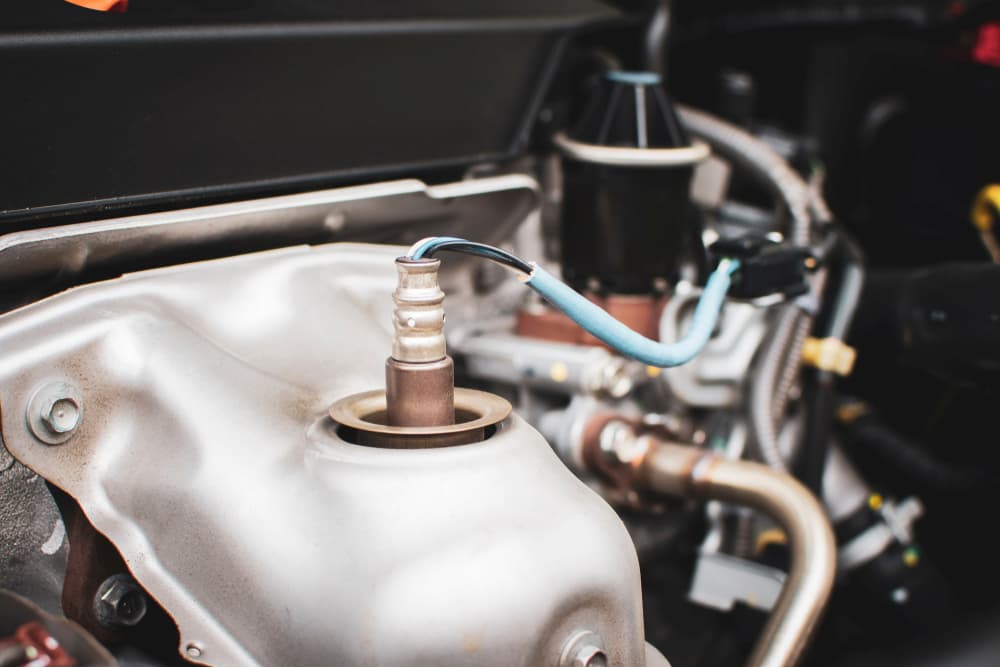When Should the Oxygen Sensor Be Replaced?

What You'll Learn
As you read about the oxygen sensor in your vehicle, you'll learn:
- Numerous signs will tell you when to replace the O2 sensor, ranging from bad gas mileage to the check engine light and beyond.
- The number of O2 sensors in each car varies, but the number of O2 sensors is twice the number of exhaust pipes you have.
- Attempting to drive for too long with a failing O2 sensor will lead to other problems that could cost thousands to fix.
How Does the Oxygen Sensor Work?
Assuming you drive a gas-powered car, oxygen is a critical component of the combustion process. Just as your vehicle needs fuel to run, it needs oxygen to allow the fuel to burn. In fact, most cars need about 14 grams of oxygen per gram of gas. The oxygen sensor is the key to keeping that ratio in check for efficient combustion.
The oxygen sensor is part of the exhaust stream, and it measures the level of oxygen in your vehicle's emissions. It passes this information to the computer in your vehicle, which processes the information and determines if the level of oxygen is appropriate or not. Good O2 levels will help your vehicle run efficiently and will even help you pass emissions tests. There are two types of O2 sensors in new vehicles: the upstream O2 sensor and the downstream O2 sensor.
These sensors are before and after the catalytic converter in your overall exhaust system and are also referred to as Sensor 1 and Sensor 2.
The Upstream O2 Sensor
The upstream O2 sensor monitors the efficiency of your engine. With the appropriate ratio of fuel to air, your engine can maximize its efficiency and power.
The Downstream O2 Sensor
The downstream O2 sensor measures the oxygen level again after it runs through the catalytic converter. The catalytic converter, or cat for short, is responsible for removing harmful emissions from the exhaust. If the two O2 sensors collectively sense that the oxygen levels don't change significantly after running through the cat, it's a sign of a bad catalytic converter.
How Many O2 Sensors Does My Vehicle Have?
There is an upstream O2 sensor and a downstream O2 sensor for each catalytic converter, and there is a catalytic converter for each exhaust pipe. In other words, there are two oxygen sensors for each exhaust pipe your vehicle has. It will usually be a multiple of two (normally two, four, or six).
What Happens When an O2 Sensor Goes Bad?
Your O2 sensors are vital to tracking your vehicle’s performance, so it's important to keep them in good health. For most vehicles, that means replacing them every 60,000 miles to 90,000 miles. If you're unsure about the recommended timeline for your specific vehicle, check the owner's manual or ask your local Chevy experts. If you don't keep up with your regular maintenance, you might notice one or more of the following signs when it's time to replace your O2 sensor:
Bad Gas Mileage
If you're filling up your tank a lot more frequently than usual, it could point to a few different problems. All of them are worth finding out about sooner rather than later, and it certainly could be your O2 sensor.
Check Engine Light
If your check engine light comes on, that's a sure sign that your vehicle is telling you to get in for maintenance as soon as possible. The mechanic will run the diagnostic test that gives you more information about why exactly the light came on. One potential cause is that an O2 sensor is failing.
Emission Test Failure
Failing an emissions test is annoying because it delays your registration, costs you money, and forces you to get repaired. For this reason, it's generally a good idea to get your O2 sensors inspected by a mechanic before you go in for the test, especially if you're due for a replacement.
Rough Idling
If your vehicle feels a little bit shaky when you're idling or even starts to stall, you are definitely having some kind of problem. Your mechanic will check the O2 sensors, among other things.
Sulfur Smell
The smell of sulfur is a sign that there's something wrong with your exhaust system, which could be the O2 sensor. For reference, sulfur smells a lot like rotten eggs. The smell is likely happening because your catalytic converter no longer filters the exhaust properly or your O2 sensor has failed, leading to a bad mixture of fuel and air.
Oxygen Sensor Replacement and Service in Phoenix, AZ
As with most car problems, the best thing you can do for a failed O2 sensor is get it checked out right away. Better yet, get regular preventative maintenance to catch problems before the start. Either way, work with a mechanic you can trust. Valley Chevy dealers have been serving the Phoenix area for years, and they've seen just about everything. Find the location nearest you and stop by for service today. We'll get to the root of the problem, talk you through your options, make the repairs, and get you back on the road as soon as possible.
FAQs
In addition to the above, there are two common questions we get about O2 sensors.
Can You Drive With a Bad Oxygen Sensor?
A bad oxygen sensor in and of itself won't necessarily prevent you from driving. Of course, your vehicle will not moderate the oxygen levels effectively, which will lead to other problems within a few days in many cases. You'll start to notice that your vehicle is sluggish, inefficient, and creating a lot of pollution. At this point, you definitely need to bring your vehicle in for maintenance before the problem spreads and leaves you stuck with really serious repairs.
How Much Does It Cost to Fix an O2 Sensor?
Unfortunately, there's just no responsible answer to give to this question without knowing more details. There are so many different components involved that the cost of repairs will depend on the situation and the vehicle. Bring it to a Valley Chevy dealer to get a quick quote and a complete assessment of your options.
Featured Image: BLKstudio/Shutterstock
